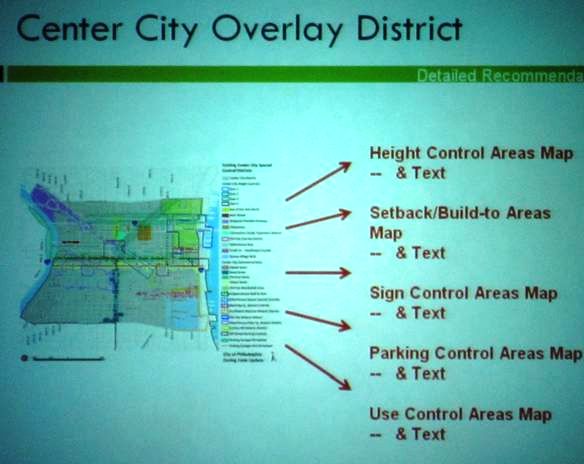Zoning Code Commission eying home stretch

September 9, 2009
By Thomas J. Walsh
For PlanPhilly
Since there are 14 Center City overlay districts currently delineated in the Philadelphia Zoning Code, how about we combine them into just one? While we’re at it, what say we make those 10 officially designated neighborhood commercial corridor overlay districts into just one as well?
They are just two of the detailed recommendations for the city’s new code that the Philadelphia Zoning Code Commission will consider as it kicked off its fall schedule early Wednesday morning. The recommendations were presented by Don Elliott of Clarion Associates, the lead consulting team for the effort.
Elliott highlighted key changes to the major code overhaul that has been underway for two years. The recommendations are now in the hands of the volunteer commissioners – more than two dozen in number – and call for “a radical simplification of Philadelphia’s zoning ordinance structure, an ambitious consolidation of zoning districts, the graphic presentation of zones, and … charts and tables that are understandable to citizens.”
The 90-page document (see below) spells out ways to affect the “modernization and simplification of permitted uses in each district,” and explain a “significant streamlining of many zoning decisions” – meaning more administrative decision-making, a reformed variance process and the codification of a “fast track” process.
A hoped-for bottom line at the Zoning Board of Adjustment: regular homeowners will be able to build a roof deck, or a screened-in back porch, and not expect to face the Spanish Inquisition for permission to do so.
“If these recommendations are followed, Philadelphia will be better able to achieve its planning goals, grow its economy, and improve the quality of its neighborhoods,” say the authors, from Clarion and its main partner, Duncan Associates. Also contributing were the team of subcontractors at work on the first re-write of the city’s zoning code in 50 years: Wallace Roberts & Todd, LLC; Claflen Associates; Dyett & Bhatia; Portfolio Associates; CHPlanning, Ltd.; and Hurley-Frank Associates.
More than 125 professional zoning code users were interviewed as part of the process that went into the new recommendations, along with public comment gleaned from 10 councilmanic district meetings earlier in 2009.
The “Detailed Recommendations” come on the heels of an official assessment of Philadelphia’s existing zoning that was presented in March of this year, followed by the “Best Practices Report” delivered by the consultants in June.
The broad goals for the new code, spelled out by the ZCC to date, are to:
• Simplify base districts (including overlay districts, as mentioned above)
• Simplify approvals
• Protect neighborhoods (including new landscaping and design standards, transit-oriented development schemes, etc.)
• Promote sustainability
• Promote quality and design
• Improve readability and reorganization of the code
There will be another round of public outreach and comment later this fall, to be documented by November as the actual re-written code comes together by this time in 2010.
“Jute or sisal” clause likely history
Use recommendations in the new report outline the additions of new uses, the removal of unnecessary restrictions and a general ability to be flexible, “particularly in commercial and mixed-use areas, so that investors and business interests can respond to market
changes quickly and efficiently as long as the impacts of the new use are similar or less intensive than the prior use.”
Tips for use regulations also include the removal of “old uses.” So ancient is the Philly Zoning Code that it regulates “rope and twine manufacture except if made of jute or sisal,” along with firms that traffic in saddlery, the manufacture of typewriters, wagon repair, phonographic records, “leather tanning, abattoirs, slaughterhouses, and stockyards” and – last but certainly not least – the “manufacture of firearms, guns, howitzers, mortars, guns, and flame throwers.”
It’s an amusing list, but might illustrate the thoroughness of the job that Clarion and its partners have performed so far. To wit: “Conversely, we understand that the phrase ‘dispense food through an aperture’ is a practice that is alive and well in Philadelphia, and the new Zoning Code should continue to address that use through appropriate conditions.”
We’re pretty sure that means you’ll still be able to get a cheese steak with broccoli rabe and provolone through the Plexiglas at Tony Luke’s.
Contact the reporter at www.ThomasJWalsh.info.
Zoning Code Commission: www.zoningmatters.org.
WHYY is your source for fact-based, in-depth journalism and information. As a nonprofit organization, we rely on financial support from readers like you. Please give today.



